Germany's top refreshing summer drinks
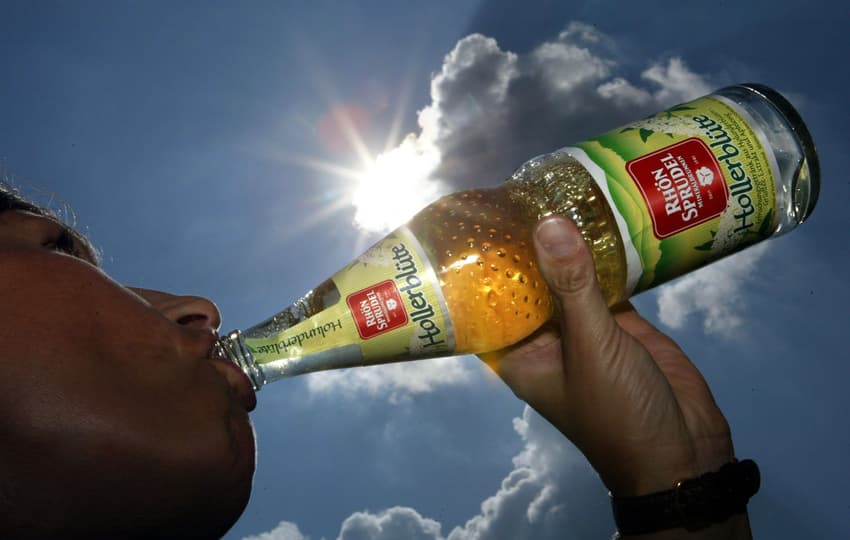
Just like countries all over Europe, there's no shortage of multinational cola and other global thirst quenchers to be had in German shops. But what do you sip when you want a little local flavour? Read on to find out...
From regional delights to national treasures, Germany has a wealth of traditions and innovations on offer when it comes to quenching your summer thirst - whether you prefer your drink with alcohol or not. Here's a few of our favourites...
1. Radler/Alsterwasser
.jpg) Various brands of Radler on a shop shelf. Photo: Boonekamp/ Wikimedia Commons
Various brands of Radler on a shop shelf. Photo: Boonekamp/ Wikimedia Commons
While the concept isn't exactly unique to Germany, the high quality and wide variety of beer on offer makes a shandy with lemonade, cola, juice or something else a favourite pick.
The mixture has different names around Germany, with Berliners preferring “Potsdamer” or “Radler” and north Germans ordering an “Alsterwasser” - after the river Alster – mixed with Pils.
“Radler” is the most common name, and is in fact the word for “cyclist” - the people who originally popularized the mixed drink.
Bavarians might ask for a “dunkles Radler” made with dark beer, or a “Russe” made with wheat beer.
And Rhinelanders use “Radler” and “Alsterwasser” to distinguish between mixes with lemonade or orangeade, while in the Munsterland you can ask for a beer/orangeade mix known as “Wurstwasser” - sausage water – so-called because it looks like water that's been used to cook sausages.
If you're feeling particularly adventurous, you could even ask for a “Diesel” - beer mixed with cola.
2. Weinschorle
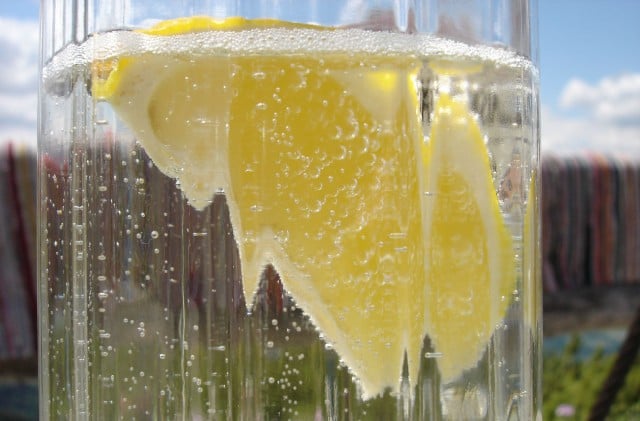 Weinschorle Photo: Birke/ Wikimedia Commons
Weinschorle Photo: Birke/ Wikimedia Commons
Mixing wine with fizzy water is hardly a German-exclusive invention either. But Germans prefer using their own country's wine, such as Riesling, Blauer Portugieser, Weißherbst, Müller-Thurgau or Silvaner.
Wine mixes can be “sour” with carbonated water or “sweet” with lemonade. And depending on the region, you might get a different ratio of wine to mixer – with grape-loving Rhineland-Pfalz preferring to add just a dash of water to an almost-full glass of wine.
3. Bowle
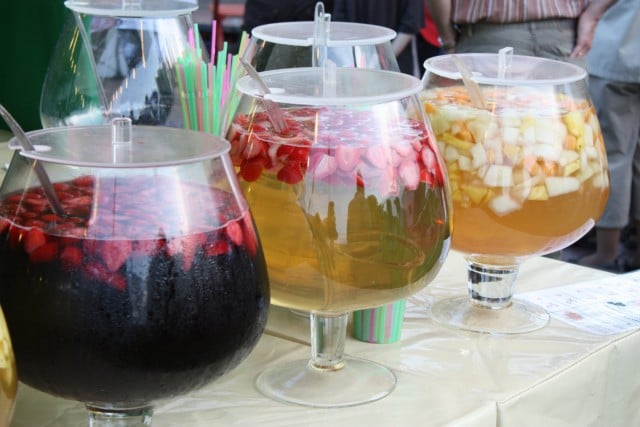 Bowle Photo: Politikaner /Wikimedia Commons
Bowle Photo: Politikaner /Wikimedia Commons
Bowle is the Germans' way of describing a punch containing chunks of aromatic, refreshing fruit. It's usually served in a large glass punch bowl which goes by the same name.
Most German punches include juice, lemonade or sparkling wine as well as white wine, and there might be a dash of rum or other spirits added. Of course, there are always the non-alcoholic versions for kids or teetotallers too.
In the Rhineland, the chunks of fruit are known as “Möppchen” and soaked in the alcohol for a day, absorbing most of it and allowing the effects of the punch to be enjoyed without drinking a drop.
4. Fassbrause
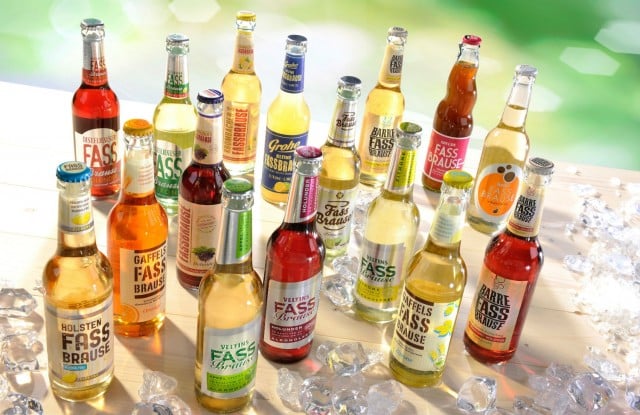 Bottles of Fassbrause. Photo: obs/Brauerei C. & A. Veltins GmbH
Bottles of Fassbrause. Photo: obs/Brauerei C. & A. Veltins GmbH
Fassbrause was originally invented in Berlin in 1908 as a mixture of fruit (apples), herbs and malt to serve as an alcohol-free substitute for beer. But since then, the word has come to mean a wide range of alcohol-free products or beer mixes like Radler.
In Berlin original-style Fassbrause made by Rixdorfer or Spreequell can still be bought on tap in some bars and is known as “Sportmolle” (sport beer) in the capital's dialect. It's often also mixed with beer.
5. Sekt
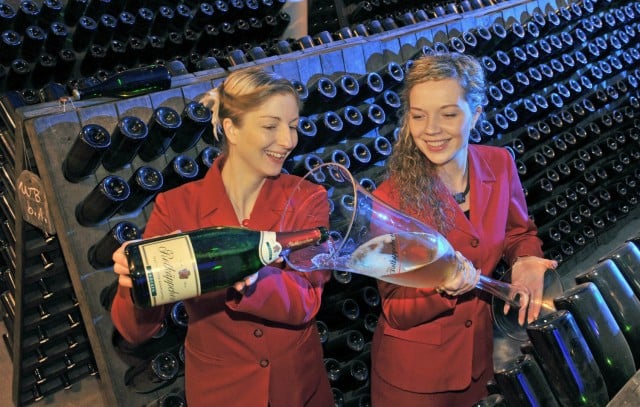 Two ladies pour out a huge glass of Sekt in the Rotkäppchen-Mumm Sekt cellar in Freyburg, Saxony-Anhalt. Photo: DPA
Two ladies pour out a huge glass of Sekt in the Rotkäppchen-Mumm Sekt cellar in Freyburg, Saxony-Anhalt. Photo: DPA
The French love champagne, but the Germans call it Sekt and have a long tradition of producing their own. The sweet sparkling white wine was inspired by Germans returning from working in French vineyards around the turn of the 19th Century and became a booming business by the 1830s – with many of the same producers still in operation today.
There was a second wave of foundings in the 1980s after market regulations were loosened and now Germany boasts more than 1,000 producers, compared with fewer than 100 in 1985.
Germany is the world's biggest market for champagne and Sekt, with around 423 million bottles sold in the country in 2009 – one quarter of the world's entire consumption of bubbly. Of those, only 80 million were imported. So organize a garden party and start enjoying those bubbles!
6. Ebbelwoi/Äbbelwoi
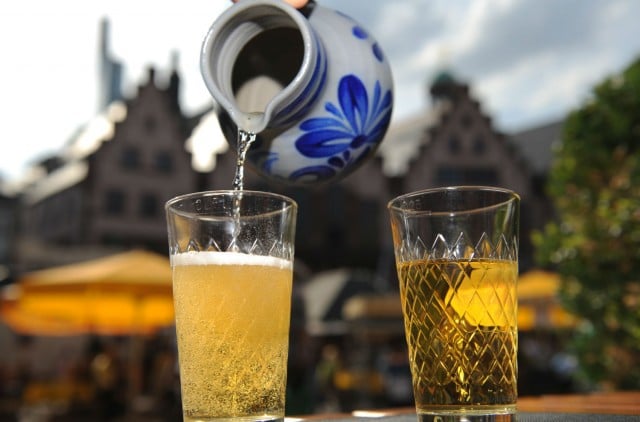 Ebbelwein being poured out in Frankfurt-am-Main. Photo: DPA
Ebbelwein being poured out in Frankfurt-am-Main. Photo: DPA
Germany's most famous apple wine is made in the state of Hesse and is a protected geographic designation. It's often also called “Schoppen” in Hessisch. In the Eifel, Saarland and Luxembourg it's still called “Viez”, after the Roman name for the brew, “vice vinum” - the backup or replacement wine.
7. Eiswein
 Frosty eiswein grapes at a vineyard in Freyburg, Saxony-Anhalt. Photo: DPA
Frosty eiswein grapes at a vineyard in Freyburg, Saxony-Anhalt. Photo: DPA
Made from grapes harvested during a sharp winter frost, Eiswein is sweeter and thicker than normal wine as much of the water is frozen out. It's served chilled, making it a fine drink to enjoy during the summer, especially as an aperitif or dessert wine.
Ice wines made from German Riesling grapes are particularly prized and are among the most sought-after sweet wines worldwide.
8. Apfelschorle
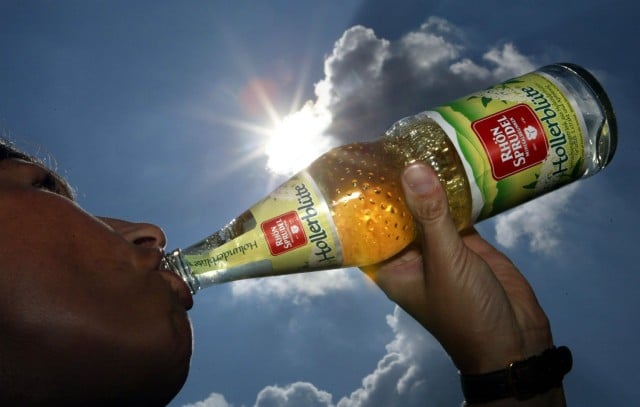 A man enjoys a refreshing gulp of apfelschorle. Photo: DPA
A man enjoys a refreshing gulp of apfelschorle. Photo: DPA
A German classic, apple juice mixed with sparkling water is often brought along as a sports drink thanks to its high mineral and sugar content that make it close to isotonic (of a similar concentration to blood).
Make sure you get the version with a high fruit content rather than a cheap one from concentrate!
9. Club Mate
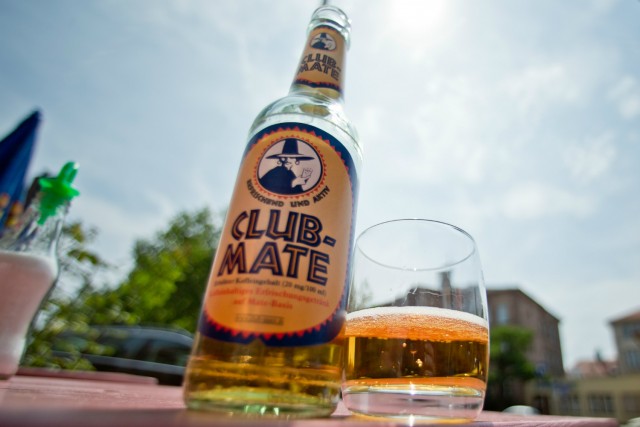 A bottle of Club Mate in Nuremberg, a city in the drink's native region of Franconia. Photo: DPA
A bottle of Club Mate in Nuremberg, a city in the drink's native region of Franconia. Photo: DPA
While most visitors to Germany might associate Club Mate with Berlin's up-all-night club culture, it's actually been produced in Franconia, Bavaria since 1924.
Club Mate's (and its many competitors') high caffeine content comes from its main ingredient, Yerba Mate – a plant found in South America that has been made into tea for hundreds of years.
As well as being widely available in big-city clubs and festivals to keep music fans bouncing around the floor for hours, it's highly prized by hackers and often ordered in large quantities by enthusiastic programmers outside Germany for special events.
For the biggest of fans, there's even a more herbal “winter edition” available for a few months of the year. And for an alcoholic version, ordering a vodka-mate in bars will often see the bar staff hand you the bottle so you can quaff enough for a shot of vodka to fit inside.
Comments
See Also
From regional delights to national treasures, Germany has a wealth of traditions and innovations on offer when it comes to quenching your summer thirst - whether you prefer your drink with alcohol or not. Here's a few of our favourites...
1. Radler/Alsterwasser
.jpg) Various brands of Radler on a shop shelf. Photo: Boonekamp/ Wikimedia Commons
Various brands of Radler on a shop shelf. Photo: Boonekamp/ Wikimedia Commons
While the concept isn't exactly unique to Germany, the high quality and wide variety of beer on offer makes a shandy with lemonade, cola, juice or something else a favourite pick.
The mixture has different names around Germany, with Berliners preferring “Potsdamer” or “Radler” and north Germans ordering an “Alsterwasser” - after the river Alster – mixed with Pils.
“Radler” is the most common name, and is in fact the word for “cyclist” - the people who originally popularized the mixed drink.
Bavarians might ask for a “dunkles Radler” made with dark beer, or a “Russe” made with wheat beer.
And Rhinelanders use “Radler” and “Alsterwasser” to distinguish between mixes with lemonade or orangeade, while in the Munsterland you can ask for a beer/orangeade mix known as “Wurstwasser” - sausage water – so-called because it looks like water that's been used to cook sausages.
If you're feeling particularly adventurous, you could even ask for a “Diesel” - beer mixed with cola.
2. Weinschorle
 Weinschorle Photo: Birke/ Wikimedia Commons
Weinschorle Photo: Birke/ Wikimedia Commons
Mixing wine with fizzy water is hardly a German-exclusive invention either. But Germans prefer using their own country's wine, such as Riesling, Blauer Portugieser, Weißherbst, Müller-Thurgau or Silvaner.
Wine mixes can be “sour” with carbonated water or “sweet” with lemonade. And depending on the region, you might get a different ratio of wine to mixer – with grape-loving Rhineland-Pfalz preferring to add just a dash of water to an almost-full glass of wine.
3. Bowle
 Bowle Photo: Politikaner /Wikimedia Commons
Bowle Photo: Politikaner /Wikimedia Commons
Bowle is the Germans' way of describing a punch containing chunks of aromatic, refreshing fruit. It's usually served in a large glass punch bowl which goes by the same name.
Most German punches include juice, lemonade or sparkling wine as well as white wine, and there might be a dash of rum or other spirits added. Of course, there are always the non-alcoholic versions for kids or teetotallers too.
In the Rhineland, the chunks of fruit are known as “Möppchen” and soaked in the alcohol for a day, absorbing most of it and allowing the effects of the punch to be enjoyed without drinking a drop.
4. Fassbrause
 Bottles of Fassbrause. Photo: obs/Brauerei C. & A. Veltins GmbH
Bottles of Fassbrause. Photo: obs/Brauerei C. & A. Veltins GmbH
Fassbrause was originally invented in Berlin in 1908 as a mixture of fruit (apples), herbs and malt to serve as an alcohol-free substitute for beer. But since then, the word has come to mean a wide range of alcohol-free products or beer mixes like Radler.
In Berlin original-style Fassbrause made by Rixdorfer or Spreequell can still be bought on tap in some bars and is known as “Sportmolle” (sport beer) in the capital's dialect. It's often also mixed with beer.
5. Sekt
 Two ladies pour out a huge glass of Sekt in the Rotkäppchen-Mumm Sekt cellar in Freyburg, Saxony-Anhalt. Photo: DPA
Two ladies pour out a huge glass of Sekt in the Rotkäppchen-Mumm Sekt cellar in Freyburg, Saxony-Anhalt. Photo: DPA
The French love champagne, but the Germans call it Sekt and have a long tradition of producing their own. The sweet sparkling white wine was inspired by Germans returning from working in French vineyards around the turn of the 19th Century and became a booming business by the 1830s – with many of the same producers still in operation today.
There was a second wave of foundings in the 1980s after market regulations were loosened and now Germany boasts more than 1,000 producers, compared with fewer than 100 in 1985.
Germany is the world's biggest market for champagne and Sekt, with around 423 million bottles sold in the country in 2009 – one quarter of the world's entire consumption of bubbly. Of those, only 80 million were imported. So organize a garden party and start enjoying those bubbles!
6. Ebbelwoi/Äbbelwoi
 Ebbelwein being poured out in Frankfurt-am-Main. Photo: DPA
Ebbelwein being poured out in Frankfurt-am-Main. Photo: DPA
Germany's most famous apple wine is made in the state of Hesse and is a protected geographic designation. It's often also called “Schoppen” in Hessisch. In the Eifel, Saarland and Luxembourg it's still called “Viez”, after the Roman name for the brew, “vice vinum” - the backup or replacement wine.
7. Eiswein
 Frosty eiswein grapes at a vineyard in Freyburg, Saxony-Anhalt. Photo: DPA
Frosty eiswein grapes at a vineyard in Freyburg, Saxony-Anhalt. Photo: DPA
Made from grapes harvested during a sharp winter frost, Eiswein is sweeter and thicker than normal wine as much of the water is frozen out. It's served chilled, making it a fine drink to enjoy during the summer, especially as an aperitif or dessert wine.
Ice wines made from German Riesling grapes are particularly prized and are among the most sought-after sweet wines worldwide.
8. Apfelschorle
 A man enjoys a refreshing gulp of apfelschorle. Photo: DPA
A man enjoys a refreshing gulp of apfelschorle. Photo: DPA
A German classic, apple juice mixed with sparkling water is often brought along as a sports drink thanks to its high mineral and sugar content that make it close to isotonic (of a similar concentration to blood).
Make sure you get the version with a high fruit content rather than a cheap one from concentrate!
9. Club Mate
 A bottle of Club Mate in Nuremberg, a city in the drink's native region of Franconia. Photo: DPA
A bottle of Club Mate in Nuremberg, a city in the drink's native region of Franconia. Photo: DPA
While most visitors to Germany might associate Club Mate with Berlin's up-all-night club culture, it's actually been produced in Franconia, Bavaria since 1924.
Club Mate's (and its many competitors') high caffeine content comes from its main ingredient, Yerba Mate – a plant found in South America that has been made into tea for hundreds of years.
As well as being widely available in big-city clubs and festivals to keep music fans bouncing around the floor for hours, it's highly prized by hackers and often ordered in large quantities by enthusiastic programmers outside Germany for special events.
For the biggest of fans, there's even a more herbal “winter edition” available for a few months of the year. And for an alcoholic version, ordering a vodka-mate in bars will often see the bar staff hand you the bottle so you can quaff enough for a shot of vodka to fit inside.
Join the conversation in our comments section below. Share your own views and experience and if you have a question or suggestion for our journalists then email us at [email protected].
Please keep comments civil, constructive and on topic – and make sure to read our terms of use before getting involved.
Please log in here to leave a comment.